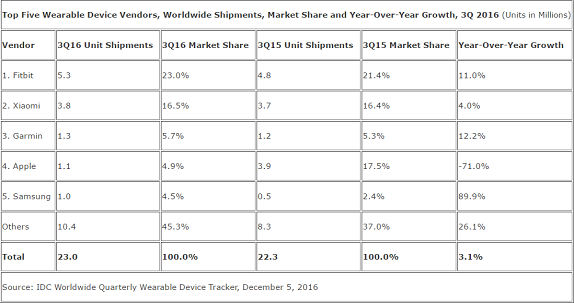

Basic wearables, primarily comprised of fitness bands, accounted for 85% of the market and experienced double-digit growth in Q3, 2016, according to latest report from the International Data Corporation, (IDC) Worldwide Quarterly Wearable Device Tracker.
The overall wearables market grew 3.1% year over year in the third quarter of 2016 (3Q16). Total wearables shipments reached 23 million in the quarter. The research firm attributed the growth to the launch of newer models, an expanding user base, and an enticing summer season that allowed people to step out of their homes. IDC expects the momentum for basic wearables to continue for the remainder of 2016 as the holiday season is now in full swing. However, smart wearables capable of running third party apps will likely continue to struggle in the near term.


Fitbit continued to maintain the lead in wearables market by shipping 5.3 million units and grabbing 23% market share in Q3, 2016. Xiaomi and Garmin took second and third spot with a market share of 16.5% and 5.7% respectively. According to IDC, Xiaomi’s new Mi Band 2 which is priced well below any competition helped it with sales. Meanwhile, Apple and Samsung were fourth and fifth with 4.9% and 4.5% market share.
Jitesh Ubrani senior research analyst for IDC Mobile Device Trackers said,
“It’s still early days, but we’re already seeing a notable shift in the market. Where smartwatches were once expected to take the lead, basic wearables now reign supreme. Simplicity is a driving factor and this is well reflected in the top vendor list as four out of five offer a simple, dedicated fitness device. Meanwhile, from a design perspective, many devices are focusing on fashion first while allowing the technology to blend in with the background.”
Ramon Llamas, research manager for IDC’s Wearables team said,
Smart wearables have been down in recent quarters, but clearly not out. As user tastes change, so will their needs. That’s the opportunity for smart wearables with multi-functionality and third-party applications, both for consumers and business users. To get there, we need to see more intuitive user interfaces, seamless user experiences, standalone connectivity, and applications that go beyond health and fitness and into personal and professional productivity.
